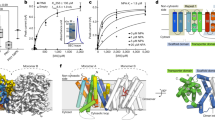Abstract.
The PIN-FORMED (PIN) protein family is a group of plant transmembrane proteins with a predicted function as secondary transporters. PINs have been shown to play a rate-limiting role in the catalysis of efflux of the plant growth regulator auxin from cells, and their asymmetrical cellular localization determines the direction of cell-to-cell auxin flow. There is a functional redundancy of PINs and their biochemical activity is regulated at many levels. PINs constitute a flexible network underlying the directional auxin flux (polar auxin transport) which provides cells in any part of the plant body with particular positional and temporal information. Thus, the PIN network, together with downstream auxin signalling system(s), coordinates plant development. This review summarizes recent progress in the elucidation of the role of PIN proteins in polar auxin transport at the cellular level, with emphasis on their structure and evolution and regulation of their function.
Similar content being viewed by others
Author information
Authors and Affiliations
Corresponding author
Additional information
Received 28 December 2006; received after revision 16 February 2007; accepted 26 March 2007
Rights and permissions
About this article
Cite this article
Zažímalová, E., Křeček, P., Skůpa, P. et al. Polar transport of the plant hormone auxin – the role of PIN-FORMED (PIN) proteins. Cell. Mol. Life Sci. 64, 1621–1637 (2007). https://doi.org/10.1007/s00018-007-6566-4
Published:
Issue Date:
DOI: https://doi.org/10.1007/s00018-007-6566-4




